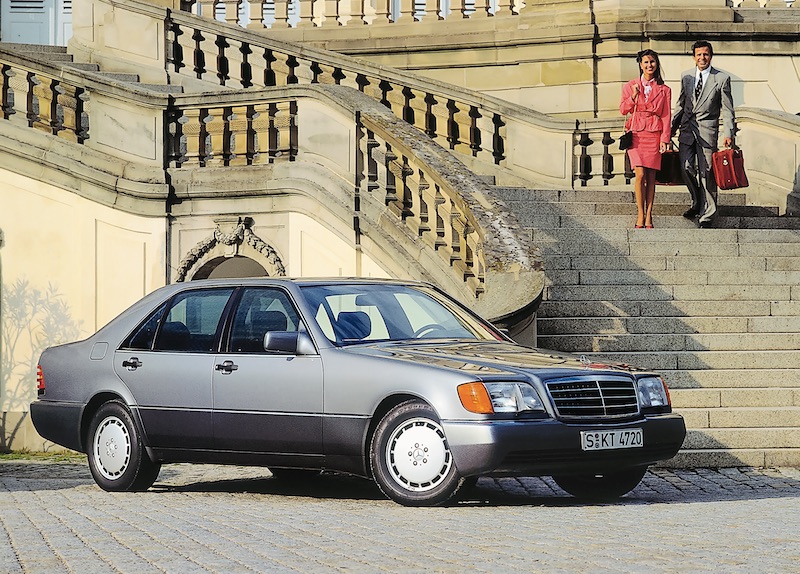 A citadel on wheels
A citadel on wheels
The W140 is perhaps one of the most controversial Mercedes-Benzes ever built. First shown at the 1991 Geneva Automobile Show, the new S-Class was highly anticipated. The launch of the W140 was delayed nearly two years in order to build the most impressive vehicle possible.
Every aspect of the W140 is in excess. To begin with, there’s the sheer size, then the blatantly imposing design, the technical innovations, the price, and the list goes on. This was the first Mercedes-Benz to have electronically controlled systems in virtually every aspect of the vehicle. Mercedes-Benz reportedly invested over one billion dollars in research and development of the W140 chassis. Substantial cost overruns on this project eventually resulted in the dismissal of Mercedes-Benz' chief engineer, Wolfgang Peter.
The W140 was designed by Mercedes-Benz’ chief designer - Bruno Sacco; although he always considered the W140 to be “four inches too tall.” There were four body variants of the S-Class: short wheelbase (W140), long wheelbase (V140), coupe (C140), and Pullman (VV140). Interestingly enough, the W140 platform later served as the basis for the Maybach 57, internally known as the W240.
The W140 was over-engineered in every way possible. For the first time on an S-Class, the grill was slanted backwards and embedded into the shape of the hood. This grill was originally intended to distinguish the V12 from its counterparts; but was eventually adapted into the final design of all models. The 6.0-liter V12 swiftly brought the two-ton beast to 60 mph in a mere 6.5 seconds.
A V16 model was in development, but the project quietly went away due to time and budgetary restraints. The W140 introduced CAN (Controller Area Network) bus technology; a system in which microcontrollers and devices could communicate with each other’s applications without the need of a host computer. ADS (Adaptive Dampening System) was introduced. This hydraulic suspension was designed to continuously adjust the dampening level of the shock absorbers in order to help optimize the vehicle’s performance during high speed or aggressive driving. The system was also particularly useful in the event the driver loses control of the vehicle. Parameter steering was introduced; which essentially adjusted the steering wheel sensitivity at low speeds for ease of maneuverability.
In 1995, ESP (Electronic Stability Program) was released on the S600 Coupe. In 1996, the W140 was fitted with BAS (Brake Assist System) which reassessed brake boost in emergency situations to provide the driver with maximum braking power at minimal effort. Side airbags and seat occupancy sensors were introduced in 1996.
There were several design nuances, all of which were a by-product of the vehicle’s mass. The W140 was so large that vehicles could not clear railway tunnels during shipping, hence the invention of power-folding mirrors. Rear power telescoping parking aerials were fitted, as drivers could not see the rear corners of the vehicle while reversing. The W140 featured a vacuum operated soft close feature for all four doors and trunk, since the weight of the doors made them difficult to shut.
Take a seat inside the W140, and you will understand why this road fortress has amassed such a dedicated fandom throughout the years. The interior is amongst the most comfortable and quiet of any vehicle you will experience. The road noise, or lack thereof, is a by-product of double paned vacuum insulated glass. All four windows were operated via one touch up/down convenience buttons.
Both the front seats and rear seats are equally comfortable and spacious; no rivalry between occupants needed. Front seats are 12-way powered with 3 memory functions and lumbar support. Orthopedic seats were available as an expensive option. These seats were comprised of several air cushions which could be individually inflated for the most postural driving position. Side bolsters were also inflatable. Vehicles may be fitted with a rear reclining bench seat, or as 2+2 seating format with a center console. All of the seats are heated, of course.
Dual-zone climate control came standard, and quad-zone climate control was available as an option. Every W140 was fitted with an activated charcoal filter in the event that a foul odor dares to enter the vehicle. The climate control system also introduced the REST feature, which allowed residual heat to circulate throughout the cabin up to twenty minutes after the engine was turned off.
Comfort and convenience were not just intended for passengers of course – the W140 introduced an array of driver convenience features. An 11-speaker Bose sound system with a trunk mounted CD changer was available. To accompany the luxurious sound system, an optional cell phone and dial pad was integrated in the W140 dashboard. The power folding mirrors were also heated, and later offered electrochromic dimming features. The interior rear-view mirror was also power operated and connected to the driver memory functions. Unfortunately, this feature went away as too many people damaged the mirrors by manually adjusting them.
The 1995 S600 Coupe was the first Mercedes to feature GSP navigation in certain markets. 1996 saw the introduction of the Linguatronic voice control system, as well as the sonar-based Parktronic parking system. In 1997 the TELEAID emergency tracking system, Xenon headlamps, and rain sensing wipers were introduced.
The W140 saw the introduction of an entirely new generation of Mercedes-Benz powerplants. The 300SE was fitted with the 3.0-liter M104 inline six-cylinder engine. The 400SE and 500SEL were fitted with variants of the 4.2-liter and 5.0-liter M119 V8 respectively. There was also a diesel powered 300SD. The 600SEL was fitted with the flagship 6.0-liter M120 V12. In 1994, the entire Mercedes-Benz lineup received a revision to their nomenclature. The “S” now precedes the model number. 300SE, 300SD, 400SEL, 500SEL, and 600SEL were now referred to as the S320, S350, S420, S500, and S600, respectively.
All of the models initially received a four-speed automatic transmission. From 1996 on, they were paired to a five-speed adaptive automatic transmission. Manual transmissions were available overseas. Starting 1998, Coupes were renamed to the CL-Class. They were now referred to as CL500 and CL600. In 1994 Mercedes gave the W140 line a mid-cycle facelift to soften the bulbous exterior lines. Production ended five years later in 1999. To mark the close of production, the S500 Grand Edition was unveiled and limited to 600 examples. As a farewell to the beloved W140, an obituary appeared in the Frankfurter Allgemeine Zeitung stating “The S-Class was always better than its reputation (…) [and was] a giant that had been taught to dance on the point of its toes”.
W140: A Modern perspective
This S-Class has managed to remain relevant in today’s world. The W140 was equipped with features that many modern cars have yet to adopt. Safety, performance, and comfort are all still impressive even to this day. Today, this S-Class is praised for what was frowned upon at its release; size and road presence. Although there is a tiger under the hood, this S-Class still purrs like a kitten.
Checkpoints:
-Inspect the body for rust. Although they tend to be durable, they will rust in northern climates.
-Inspect all convenience features for electronic gremlins.
-PSE (pneumatic system equipment) pump can fail due to vacuum leaks within the system
-Inspect motor mounts. They are fluid filled, and can cause vibrations at idle if collapsed.
-Pre-1996 air conditioning evaporators may leak (repair requires disassembly of entire dash)
-A biodegradable wiring harness was used 1993-1995. Ensure that such wiring harnesses have been replaced. This is a very expensive repair and in some cases parts are no longer available.
-Rear window regulators are known to fail. Inspect for clicking noises.
-Power steering pumps may leak. On V12 models, the power steering pump is a tandem unit that powers the self-levelling suspension.
-Inspect LH-Jetronic fuel injection. If not driven regularly, inspect the system for leaks, and chek for smooth running from cold start to operating temperature.
-Service records are key.
Reasons to buy a W140:
-State of the art safety features for its time
-Exquisite road presence
-Extremely isolated ride
-Mechanical components are all reliable and have stood the test of time
-Electrical components have stood the test of time
-High build quality
-Corrosion resistance substantially better than its predecessor
-Relatively affordable purchase price, although it may be hard to come by a well-kept example.
Reasons not to buy a W140:
-First generation of electronics can be troublesome; ensure that updates or replacements have sorted.
-S350 Diesel known as the “rod bender”
-V12 cost of service substantially more than six and eight-cylinder models
-Difficulty in diagnosing certain issues in pre OBD-II cars
-Heavy fuel consumption
Technical Specifications: 1992-1999 W140 Sedans & Coupes
SEDAN Years Production Engine HP [SAE] Torque [lb-ft]
350SD/S350D 1991-’94 14,257 3.5L I6 148 229
300SE/SEL 1991-’94 101,123 3.2L I6 228 229
400SE/SEL 1992-’93 15,541 4.2L V-8 275 347
500SE/SEL 1992-’93 30,833 5.0L V-8 315 347
600SE/SEL 1992-’93 17,802 6.0L V-12 389 420
S320 1994-’99 20,433 3.2L I6 217 233
S420 1994-’99 12,459 4.2L V-8 275 347
S500 1994-’99 22,073 5.0L V-8 315 345
S600 1994-’99 7,286 6.0L V-12 389 420
Transmission Rear Axle 0-62 mph Top Speed MPG [US]
350SD/S350D 4-A 2.82 12.5 sec 115 20-23
300SE/SEL 4-A 3.46 8.9 sec 139 15-19
400SE/SEL 4-A 2.82 7.6 sec 149 13-17
500SE/SEL 4-A 2.65 6.6 sec 155 13-16
600SE/SEL 4-A 2.65 6.3 sec 155 11-15
S320 4-A 3.46 8.0 sec 139 18-24
S420 4-A/5-A 3.46 7.1 sec 149 19-26
S500 5-A 2.65 7.1 sec 155 16-20
S600 5-A 2.65 6.5 sec 155 12-16
COUPE Years Production Engine HP [SAE] Torque [lb-ft]
500SEC/S500 1993-’97 7,104 5.0L V-8 322 354
600SEC/S600 1993-’97 7,475 6.0L V-12 389 420
CL500 1998-’99 837 [’98] 5.0L V-8 315 345
CL600 1998-’99 231 [’98] 6.0L V-12 389 420
COUPE Transmission Rear Axle 0-62 mph Top Speed MPG [US]
500SEC/S500 4-A 2.65 6.6 sec 155 13-16
600SEC/S600 4-A 2.65 6.3 sec 155 11-15
CL500 5-A 2.65 6.5 sec 155 13-17
CL600 5-A 2.65 6.2 sec 155 12-16
